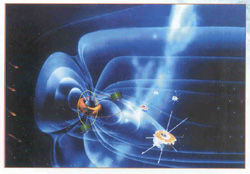

As of July, scientists at the CAS Center for Space Science and Applied Research (CSSAR) have been busy modulating and testing the payloads that will be onboard a space exploration satellite, marking start of the countdown for China's Double Star program.
As its name suggests, the mission will involve two satellites, both of which will be designed, developed, launched and operated by China. They will be launched within a year into a large elliptic orbit of the equator and large elliptic polar orbit, respectively. The first one will be sent into orbit later this year.
The mission will enable scientists to obtain simultaneous data about the changing magnetic field and population of electrified particles in different regions of the magnetosphere. The idea was first brought up by CAS Member Liu Zhenxing and his team at CSSAR in 1997. What makes the program special is that it will make observations that the exploration satellites from other countries have failed to cover, including those from the Cluster II mission of the European Space Agency (ESA).
In 2001, a joint agreement for European participation in China’s Double Star Program was signed between the Chinese National Space Administration and ESA. A key part of the collaboration is the Double Star's inclusion of identical instruments that have already flown on ESA's Cluster mission.
Together with the four European satellites in the Cluster Program, China's dual-spacecraft mission will be deployed in parallel at six different sections of the magnetosphere, thus effectively monitoring its variations.






